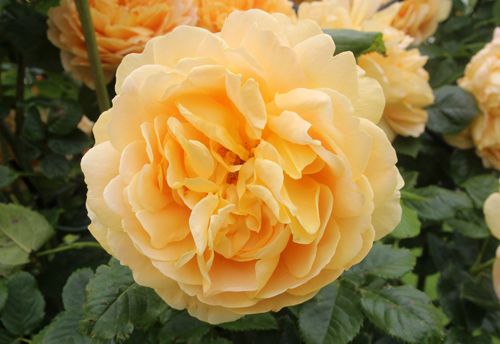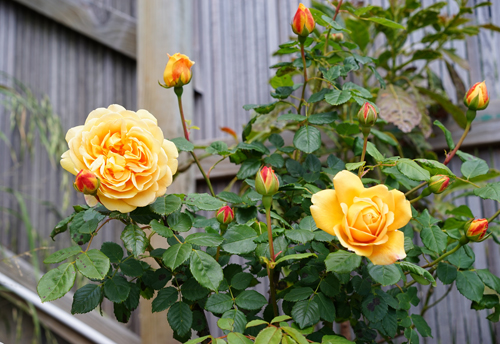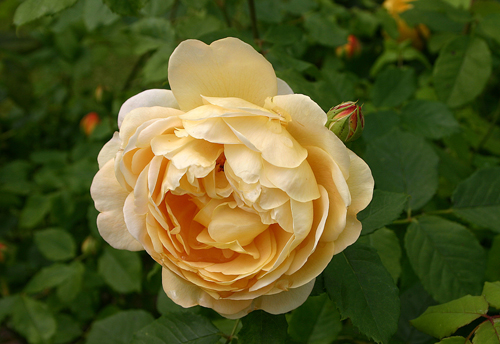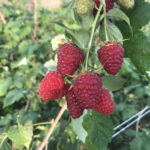Rose Golden Celebration
For about twenty years, this rose has been one of the most widespread and popular in Europe. She is well known in other regions of the world as well. She is an example of an almost flawless flower that harmoniously combines decorative qualities with technical characteristics. "Golden holiday" - this is how its name can be translated. Indeed, if you grow this beauty in your garden, the festive atmosphere will become its constant companion!

History of creation
Our current heroine, according to the classification, belongs to the so-called English roses of Austin. This is not quite official, but a well-known group that combines the features of old European roses and modern, hybrid tea varieties. In appearance, it is a bush rose - a scrub.
From what has been said, it is clear that the legendary British company David Austin Roses was the originator of the variety. It was obtained in 1992 under the working title AUSgold, and a few years later began to receive the first trade patents in various countries.
The famous roses Charles Austin and Abraham Darby were used to hybridize the new variety. Over the past decades, Golden Celebration has received many prizes and diplomas from prestigious international exhibitions. By the way, the breeder dated her name to the anniversary of the Queen of Britain. Perhaps this "royal essence" still influences the fate of the unfading flower?

Description of appearance
The bush is powerful, spreading, from 120 to 150 cm high, about the same width. Shoots are strong, slightly drooping; in warm climates, they stretch noticeably, and then the specimen can be used as a climbing rose. The number of thorns on the shoots is relatively moderate. The color of hard, dense leaves is deep green, with a noticeable glossy sheen.
Interesting! One of the many awards for this rose is a diploma for the best bush shape.
The main pride of the variety is its flowers! They have a bright color, which is most often compared to the color of the orange egg yolk. However, pinkish and peach tones are always mixed with it, created by many small pink dots that are difficult to see at a cursory examination. The result is a golden copper flower, very large, up to 14 cm in diameter (one of the largest roses in the world). Surprisingly, for Austin varieties, yellow is not at all typical!
On a bush, flowers grow in the form of small brushes, which usually droop a little under their own weight. Remontant flowering, going in several waves, the strongest of which is the first, in early summer.

When describing this rose, one should not miss its scent! It is strong to medium, firm, sweet-fruity. Romantic gardeners pick up honey or tea notes in it, and sometimes even compare it with a barely noticeable lemon scent.
Features of agricultural technology
According to the US Department of Agriculture (USDA), Golden Celebration is capable of growing in zones 5 to 10, although there is ample evidence that already at -18 ° its shoots begin to freeze noticeably. In any case, in Central Russia, the rose must be covered for the winter.
Resistance to common diseases is good, with the exception of black spot. For this reason, the bushes should be planted in a well-ventilated, sufficiently lit area, avoiding thickening.
Possibilities of use
First of all, it is a rose of the main plan, capable of attracting attention with its sunny, bright appearance. As a specimen plant, it is beyond competition! Looks great near the central gate, at the entrance to the house, on a small open lawn.
As already mentioned, it is often (especially in southern countries) used to decorate high arches, walls of buildings, fences - as a climbing rose. It is often sold as a container specimen, but in this case it requires timely trimming.
It is difficult to find a person who would be dissatisfied with the Golden Celebration rose, once planting it on his site! After all, you must admit that everything is fine in her, as in a real queen!









I have a twofold attitude towards this rose. On the one hand, the variety is very winter-hardy, grows well and quickly, turning into a good voluminous bush. There are always a lot of buds, blooms profusely, practically without interruption from late spring to frost. The flowers are huge (up to 14 cm), the shape is amazing, the color of the petals is wonderful - not transmitted, constantly changing. But the plant is often sick, the flower lasts only a few days, fades ugly, and even when it blooms, you need to contrive to see the rose - the flower hangs "face down".